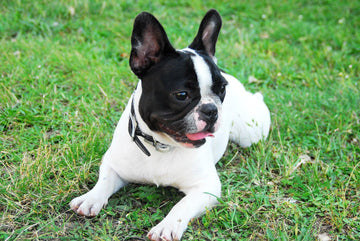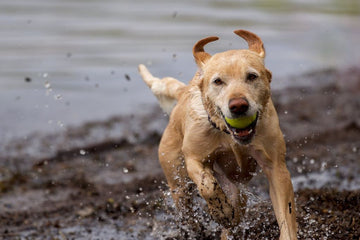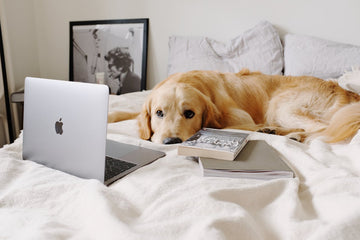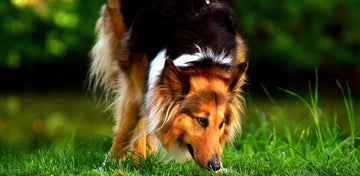Benefits of Regular Exercise for Puppies (With Exercise Suggestions)
by Bethel Farms on Mar 14, 2023

Around 48 million households in America own at least one dog, making it by far the country's most popular pet. Dogs can provide protection and companionship. Taking care of your dog is also a great way to stay fit and get out in the fresh air.
This is because all dogs need regular exercise, and this includes puppy exercise. An interesting and varied exercise regimen will keep your dog happy and healthy.
However, it is incredibly important to choose the right kind of exercise for your dog. This will keep it entertained and ensure that your dog doesn't sustain any injuries while exercising.
Are you struggling to decide what sort of exercise your new dog needs? Then you're in the right place! Read on to find out all the amazing benefits of exercise for dogs and some great ideas to try out with your beloved pet!
Benefits of Exercise For Dogs
When it comes to exercise, humans aren't the only species that benefits from doing this regularly. There is a whole host of benefits that your dog can enjoy by doing regular exercise.
Let's take a closer look at some of the most important exercise benefits for dogs.
Regular Exercise Keeps Your Dog Healthy
Around 30% of dogs in America are overweight, and this can cause serious problems for your pet.
It can make it more difficult for them to move and socialize with other animals. It will also make them more susceptible to health issues.
Regular exercise is an important part of your dog's healthy diet. It ensures that they use the energy they get from their food so they don't put on more weight than they need.
It also keeps their joints strong and mobile, which is particularly important as your dog gets older. Moving around helps them build up the cartilage in their joints, making them less likely to develop arthritis.
Exercise Is Important For Your Dog's Mental Health
Regular exercise isn't just good for your dog's physical health, it is also important for their emotional well-being. It shows them that you want to spend quality time with them and gets them out in the fresh air.
Like humans, dogs release endorphins when exercising and socializing with other dogs, which makes them feel happy. This can reduce feelings of anxiety and even depression.
Exercise Challenges Your Dog's Body and Brain
Dogs are incredibly intelligent animals, so they need mental stimulation as well as physical stimulation.
Exploring new places or doing training exercises helps their cognitive development. This stops them from getting bored and gives your dog an opportunity to learn a whole range of new skills.
Puppy Exercise Is an Important Part of Bonding
Spending time with your dog is incredibly important for bonding but this doesn't just mean sitting on the couch with them. Exercise gives your pet valuable, focused quality time with you.
This helps them feel safe and secure around you. It also means that they will listen more to commands, which makes training them easier.
How Often Should Your Dog Exercise?
Most dogs need daily exercise. You should aim to at least take them out for a walk twice a day.
Of course, you might do one session of strenuous exercise, such as swimming or going for a long walk, each day. Then you can top this up with a gentler exercise in the afternoon or evening.
Playing fetch with your dog or doing 15 minutes of training with them later in the day is a great way to burn off any excess energy they have.
Can You Over-Exercise a Dog?
Regular exercise will do your dog the world of good, but it is possible to over-exercise them. Dogs need between 20 minutes and 2 hours of exercise each day.
The amount of exercise your dog needs will depend on a lot, including:
- How big they are
- Their fitness
- How old they are
- Any health conditions that they have
- The weather you're exercising in
Because of this, it is important to ease your dog into their exercise regime and watch their behavior. This will tell you whether they need more or less exercise.
For example, if your dog is getting very hyperactive in your home, they may need more exercise. Dogs will also push back if they are feeling overworked. You might find that they resist going out for a walk or stop running for their ball.
This can also happen if they are feeling anxious or scared in certain environments. However, if your dog is in a familiar place and they behave like this, they might just be worn out!
Choosing the Right Type of Exercise For Your Dog
Most full-grown dogs can manage a whole range of different exercises.
However, choosing the wrong types of exercise for certain dogs can lead to injuries. Age and certain health conditions can affect the type of exercise that suits your pet.
Here are some important things to keep in mind when exercising certain dogs.
Young Dogs
If you have a puppy, its body is still developing. This means that its growth plates won't have closed yet.
Because of this, strenuous repetitive activities such as running or jumping can damage their joints. So it is very important not to over-exercise your puppy. Instead, exercise them regularly for short periods of time and switch up the type of exercise you do with them.
Most dogs have reached physical maturity by the age of one, so after this, they can handle longer, more strenuous periods of exercise safely.
Dogs Recovering From Surgery or Health Conditions
If your dog has recently had surgery or suffers from certain health conditions, such as canine arthritis, they might not be able to handle strenuous exercise. In fact, this could cause serious health complications.
Because of this, they should only do light, low-impact exercises. You should speak to your vet before taking your dog out for exercise.
Overweight Dogs
If your dog is overweight, it is important to ease them into exercise. Their extra weight will put more strain on their joints. So don't start taking them on runs or doing vigorous exercise straight away.
Instead, take them on gentle walks or go swimming with them. Even doing 15 minutes of gentle exercise each day will make a difference. As they get fitter, you can start introducing other types of exercise to their routine.
The Importance of Creating a Regular Exercise Regime
Of course, your schedule can vary a lot from day to day, and this might mean that you can't always take your dog for a long walk every day.
However, where possible, it is important to create a regular exercise regimen with your dog. This might include:
- Taking them out for a walk at the same time each day
- Doing training each evening
- Going to training or swimming classes on the same day each week
- Using the same words to invite them to exercise (such as "walkies" or "swim time")
- Spacing out their exercise throughout the day so they don't get exhausted
This doesn't just help you plan your time. It also creates security and certainty for your dog.
They will start to understand when they can expect to go for a walk or attend a training class. This means that they will also be more patient between these activities.
You might not always be able to stick to the exact exercise regimen for your dog. For example, if you are on vacation, you might have to adjust when and where you take your dog for a walk.
They should be okay with minor changes to this routine. Just ensure that they've done some exercise by 9 am. This might be as simple as letting them out for a run in the backyard and will stop them from getting agitated.
Great Exercises to Try With Your Dog
As your dog gets older, you will be able to figure out which activities they enjoy most. So you can build these into their exercise routine.
However, as they say, variety is the spice of life! Trying out different activities with your dog will help them develop new skills and keep them entertained.
With that in mind, here are some great exercises that your dog is sure to enjoy.
Going for Walks
Walking is a great low-impact exercise and is perfect for dogs of all shapes and sizes. This also gives them the chance to explore new places and socialize with other pets.
When walking your dog, start by going a short distance — a 20-minute walk is perfect for young puppies and older or overweight dogs. Then you can start increasing the length of your walks once you are confident that they can handle the distance.
As your dog gets older and more comfortable with walking, you can start exploring new environments.
If you enjoy this type of fitness, you could also try taking them for a jog or a run. This is a high-impact exercise for dogs, so don't do it with puppies or older dogs. You should also introduce this gradually — start with a jog and move on to a run once your dog feels comfortable with jogging.
Playing Fetch
Fetch is a great way to give your dog a workout without having to do too much work yourself!
Find an open space and take a ball or stick for them to chase after. If you stand at the top of a slope, your ball will also go further so they'll have to work more. Then call them to bring it back to you.
This can take a bit of training and practice, especially with younger dogs. So give them lots of praise when they do bring the ball back. Once they've got the hang of it, fetch will quickly become one of your dog's favorite games!
Swimming
Swimming offers an amazing, low-impact workout, so it's great for older dogs and dogs with arthritis.
You can take your dog to special canine pools or bodies of water that are safe for them to swim in. Avoid water with lots of reeds or strong currents in it.
You can support your dog by taking them into the water on their first swimming session. Floating a ball for them to chase can also encourage them to get moving. They should pick it up in no time at all!
Of course, some dogs simply don't enjoy swimming. In that case, avoid it — forcing your dog to do something they don't like won't benefit either of you.
Obedience Training
Obedience training gives your dog a physical and mental workout and is a great bonding exercise.
Start with simple commands, such as sit, walk, stay, and come. Then you can move on to more impressive tricks, such as bowing, rolling over, or shaking hands.
Treats and praise are also key to obedience training. So make sure you reward them when they learn a new trick!
Nose Work Games
Nose work games are easy to do in the house and get your dog moving. They also improve their scent-finding skills.
Put a few treats in small boxes around the house and create a scent trail to each box. Then ask your dog to "go find it".
Your dog will have to hunt for the boxes using their nose. Once you've found it, you can reward them with the treat from inside the box and give them plenty of praise!
Hide and Seek
Hide and seek is a great way to add a bit of fun to your dog's exercise regimen.
Get your dog to sit and stay outside a room in your home. Then go and hide somewhere in the room and call them to come. Your dog will have to hunt for you in the room.
This gets them moving and is a brilliant way to support their cognitive development.
Keep Your Pet Happy and Healthy With Brilliant Puppy Exercises
As you can see, there are plenty of amazing things you can do with your dog to keep it happy and healthy.
That said, it is important to choose exercises that suit your pet and their abilities, especially when it comes to puppy exercise. This will ensure they don't get worn out or suffer an injury. Keep these top tips in mind and you won't go wrong!
Are you settling a new puppy into your home? Then potty training will be a big part of your life. Check out our amazing, all-natural puppy pee pads now for a simple potty training journey!




